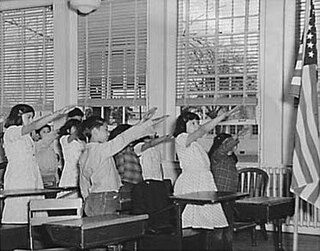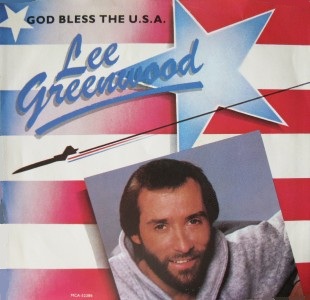
The Pledge of Allegiance is a patriotic recited verse that promises allegiance to the flag of the United States and the republic of the United States of America. The first version, with a text different from the one used at present, was written in 1885 by Captain George Thatcher Balch, a Union Army officer in the Civil War who later authored a book on how to teach patriotism to children in public schools. In 1892, Francis Bellamy revised Balch's verse as part of a magazine promotion surrounding the World's Columbian Exposition, which celebrated the 400th anniversary of Christopher Columbus' arrival in the Americas. Bellamy, the circulation manager for The Youth's Companion magazine, helped persuade then-president Benjamin Harrison to institute Columbus Day as a national holiday and lobbied Congress for a national school celebration of the day. The magazine sent leaflets containing part of Bellamy's Pledge of Allegiance to schools across the country and on October 21, 1892, over 10,000 children recited the verse together.

Francis Julius Bellamy was an American Christian socialist Baptist minister and author. He is best known for writing the original version of the Pledge of Allegiance in 1892.
West Virginia State Board of Education v. Barnette, 319 U.S. 624 (1943), is a landmark decision by the United States Supreme Court holding that the First Amendment protects students from being compelled to salute the American flag or say the Pledge of Allegiance in public schools.
Minersville School District v. Gobitis, 310 U.S. 586 (1940), was a decision by the Supreme Court of the United States restricting the religious rights of public school students under the First Amendment to the United States Constitution. The Court ruled that public schools could compel students—in this case, Jehovah's Witnesses—to salute the American flag and recite the Pledge of Allegiance despite the students' religious objections to these practices. This decision led to increased persecution of Witnesses in the United States. The Supreme Court overruled this decision three years later in West Virginia State Board of Education v. Barnette (1943).

The flag of the state of Michigan is a coat of arms set on a dark blue field, as set forth by Michigan state law. The governor has a variant of the flag with a white field instead of blue one. The state has an official flag month from June 14 through July 14.

The flag of Texas is the official flag of the U.S. state of Texas. It is well known for its prominent single white star which gives the flag its commonly-used name: "Lone Star Flag". This lone star, in turn, gives rise to the state's nickname: "The Lone Star State". The flag, flown at homes and businesses statewide, is highly popular among Texans and is treated with a great degree of reverence and esteem within Texas. Along with the flag of Hawaii, it is one of two state flags to have previously served as a national flag of an independent country. In 2001, the North American Vexillological Association surveyed its members on the designs of the 72 U.S. state, territorial, and Canadian provincial flags and ranked the Texas flag second, behind New Mexico.

An oath of allegiance is an oath whereby a subject or citizen acknowledges a duty of allegiance and swears loyalty to a monarch or a country. In modern republics, oaths are sworn to the country in general, or to the country's constitution. For example, officials in the United States, take an oath of office that includes swearing allegiance to the United States Constitution. However, typically in a constitutional monarchy, such as in the United Kingdom, Australia, and other Commonwealth realms, oaths are sworn to the monarch. Armed forces typically require a military oath.

The Bellamy salute is a palm-out salute created by James B. Upham as the gesture that was to accompany the American Pledge of Allegiance, whose text had been written by Francis Bellamy. It was also known as the "flag salute" during the period when it was used with the Pledge of Allegiance. Bellamy promoted the salute and it came to be associated with his name. Both the Pledge and its salute originated in 1892. Later, during the 1920s and 1930s, Italian fascists and Nazi Germans adopted a salute which was very similar, attributed to the Roman salute, a gesture that was popularly believed to have been used in ancient Rome. This resulted in controversy over the use of the Bellamy salute in the United States. It was officially replaced by the hand-over-heart salute when Congress amended the Flag Code on December 22, 1942.

Michael Arthur Newdow is an American attorney and emergency medicine physician. He is best known for his efforts to have recitations of the current version of the Pledge of Allegiance in public schools in the United States declared unconstitutional because of its inclusion of the phrase "under God". He also filed and lost a lawsuit to stop the invocation prayer at President Bush's second inauguration and in 2009 he filed a lawsuit to prevent references to God and religion from being part of President Obama's inauguration.

"God Bless the U.S.A." is an American patriotic song written and recorded by American country music artist Lee Greenwood, and is considered to be his signature song. The first album it appears on is his 1984 album You've Got a Good Love Comin'. It reached No. 7 on the Billboard magazine Hot Country Singles chart when originally released on May 21, 1984. That summer, the song was included in a film about President Ronald Reagan, the Republican presidential nominee, that was shown at the 1984 Republican National Convention. "God Bless the U.S.A." gained prominence during the 1988 United States presidential election campaign, when Greenwood performed the song at the 1988 Republican National Convention and at rallies for the Republican nominee, George H.W. Bush. The song was also featured in television advertisements for Bush. The song became popular again during the Gulf War in 1990 and 1991. As a result of its newfound popularity, Greenwood re-recorded the track for his 1992 album American Patriot.
An oath of citizenship is an oath taken by immigrants that officially naturalizes immigrants into citizens. It is often the final step in this process, and is usually done in a ceremonial capacity. An oath of citizenship is designed to be a statement of patriotism and loyalty to the new country. In countries which retain a monarchical system of government, an oath of allegiance to the monarch is often required as well. Adding an oath to God to the end of an oath is usually optional.

The Christian Flag is an ecumenical flag designed in the late 19th century to represent much of Christianity and Christendom, however is used by Protestant denominations only. Since its adoption by the United States Federal Council of Churches in 1942, it has been used by congregations of many Christian traditions, including Anglican, Baptist, Congregationalist, Lutheran, Mennonite, Methodist, Moravian, Presbyterian, and Reformed, among others.
Ceremonial deism is a legal term used in the United States to designate governmental religious references and practices deemed to be mere cultural rituals and not inherently religious because of long customary usage. Proposed examples of ceremonial deism include the reference to God introduced into the Pledge of Allegiance in 1954, the phrase "In God We Trust" on U.S. currency, and the Ohio state motto, "With God, all things are possible".
The Pledge of Allegiance of the United States has been criticized on several grounds. Its use in government funded schools has been the most controversial, as critics contend that a government-sanctioned endorsement of religion violates the Establishment Clause of the First Amendment to the U.S. Constitution. Arguments against the pledge include that the pledge itself is incompatible with democracy and freedom, that it is a form of nationalistic indoctrination, that pledges of allegiance are features of current and former totalitarian states such as Nazi Germany, and that the pledge was written to sell flags.

George MacPherson Docherty was a Scottish-born American Presbyterian minister and principal initiator of the addition of the words "under God" to the Pledge of Allegiance to the Flag of the United States.

Louis Charles Rabaut was an American lawyer and politician from the U.S. state of Michigan. He was a Democratic congressman representing Michigan's 14th congressional district from 1935 to 1947, and from 1949 to 1961.
...And Justice for All may refer to:
One Nation Under God may refer to:










